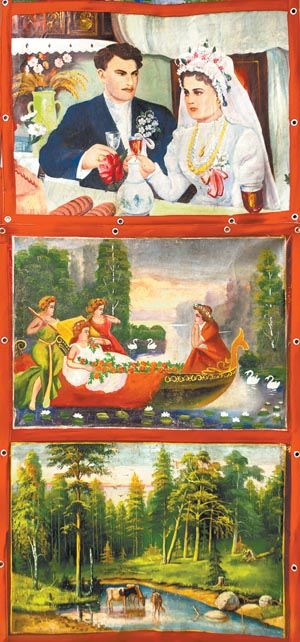“Provincial glamour” preceding glossies and telenovelas
Museum of Modern Ukrainian Art exhibits Ukrainian amateurish paintings of the 1930s-1960s
The author of the project and collection owner Antin MUKHARSKY told The Day about the peculiarities of the Provincial Glamour exhibit:
“I bought the first works of my collection about 20 years ago. The idea of the project and the term of the ‘provincial glamour’ appeared at the beginning of the 2000s. In this way, I tried to describe the particular social, cultural and economic phenomena, namely, the Ukrainians’ inclination to the exterior brightness that often does not correspond to their income. When countrymen came to town and started playing ‘townspeople.’ Actually, these paintings preceded the passion of Ukrainians for glossies and the Mexican [Latin American. – Ed.] telenovelas.
“These are the works of the folk art, which I decided to collect and present not as kitsch paintings but as Ukrainian national pop art. They have all the pop art components: replicated typical plots, popular stories with which average people fill up their leisure time and interiors. Nobody has presented them in this context yet. The amateurish paintings made the pop culture of the 1930s-1960s.
“This art appeared due to people’s living conditions of that time. Its best representatives had been destroyed and the rest were put into the ‘stall.’ People dreamed about the beautiful and bright life, and the pictures that made tremendous impression with their orgy of colors and fertile imagination appeared. The amateurish paintings differed from the artisan ones since the painters offered them for sale. The plots in much demand were replicated. The oldest works of my collection are dated to the 1930s. Previously, they did not sell artworks at the markets. It was rather a postwar phenomenon. After the war the government allowed self-employment and whole cooperatives were created. In the 1960s, they [government. – Ed.] started struggling with them, withdrew their licenses and tried to eliminate this art.
“Among the plots of the amateurish paintings a dozen most popular ones can be singled out: Three Heroes, Olenka, Flowers, Swans, and others. This is the phenomenon of the national culture. Olenka usually portrays a pensive lady, whom countrywomen looked at and dreamed: ‘One day I will also become beautiful, I will have my hair done and decorated with flowers.’ The specialists still argue about Olenka origin. Some of them say that it might be the sister Alyonushka from the Russian fairy tales. I uphold the version that it was inspired by the German postcards. The popular Bavarian cards depicted a girl and a deer with a castle in the background; our pictures do not have the castle, the deer is decorated with a wreath and the girl wears the Ukrainian dress instead of the German one. The straw hat at her feet is the symbol of woman’s liberation which comes from Victorian Britain. It is the symbol of freethinking and marks the beginning of emancipation. Of course, the people did not know where Olenka had come from and how this plot had developed. People just liked the charisma of the girl in the painting.
“Another popular plot was People Going to the Church. It was usually given for various holidays: christening and wedding ceremonies. Every picture was given on a special occasion. For example, Flowers served as postcards. Some women had 10 to 12 similar pictures! Swans were usually given to happy families for the family holidays: weddings, engagements, silver anniversaries, etc. Funny pictures called ‘You had better hide, Petro and Natalka, the mom is coming with a beater’ and ‘The Rivals’ were usually given to the single girls, divorced women and even to widows. These were the folk variations of the famed Mykola Pymonenko’s paintings.
“None of the pictures is signed. Some of them have signatures on the inner side indicating when and where they were bought. Some of the reverse sides are covered with the newspapers of the 1950s-1960s. In this case the issue date is likely to be the date of purchase. They painted on the oilcloth and the cloth for parcels’ wrapping sold at post-offices: cotton, thin calico or flax. Painters took a chalk, mixed it with gelatin, grounded the canvas and painted with oils. They also used the special tracing papers. The essential condition of a classical amateurish painting was the red edge. In 1970, this art started degrading. The painters started using bright paints – gouache and the paints from the school sets.
“I know about 30 centers of the amateurish paintings. They are situated mainly in central and northern Ukraine in Sumy, Chernihiv, Poltava, Kyiv and Kharkiv regions. One painter created up to a hundred works a year. One painting took them about three days. They had a certain corporate culture. The painters gathered and learnt to paint so that the works resembled each other and it was impossible to control the number of works each painter created.
“When the painters got tired of the common plots they created their own ones. These works reflect the beautiful life provincial painters imagined. They depict mountains, pigeons, mermaids, dreamy girls, swans, etc. The religious plots were common in western Ukraine. The painting plot Girl in a Boat resembles Amedeo Modigliani’s style by its elongated silhouette and interesting modern composition. The amateurish paintings often depict the Ukrainian houses and mountain landscape which one can see somewhere in Thailand. Sometimes the painters even afforded themselves to paint naked figures.”
Mukharsky’s collection has about 1,000 works. This year’s exhibit for the first time in the Ukrainian Home three years ago. This year’s exhibit comprises 80 separate works and a solid canvas of 600 works of inferior quality. The exhibit will take place from August 26 through September 4. Additionally, the organizers plan to present the Provincial Glamour catalog.






